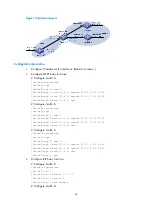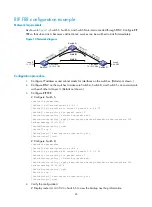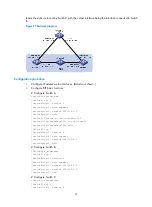
42
[SwitchD-rip-1] undo summary
# Configure Switch E.
<SwitchE> system-view
[SwitchE] rip 1
[SwitchE-rip-1] network 1.0.0.0
[SwitchE-rip-1] version 2
[SwitchE-rip-1] undo summary
# Display the IP routing table of Switch A.
[SwitchA] display rip 1 database
1.0.0.0/8, cost 0, ClassfulSumm
1.1.1.0/24, cost 0, nexthop 1.1.1.1, Rip-interface
1.1.2.0/24, cost 0, nexthop 1.1.2.1, Rip-interface
1.1.3.0/24, cost 1, nexthop 1.1.1.2
1.1.4.0/24, cost 1, nexthop 1.1.2.2
1.1.5.0/24, cost 2, nexthop 1.1.1.2
1.1.5.0/24, cost 2, nexthop 1.1.2.2
The output shows that two RIP routes can reach network 1.1.5.0/24. Their next hops are Switch
B (1.1.1.2) and Switch C (1.1.2.2) respectively, with the same cost of 2. Switch C is the next hop
router to reach network 1.1.4.0/24, with a cost of 1.
3.
Configure an additional metric for the RIP interface:
# Configure an additional metric of 3 for VLAN-interface 200 on Switch A.
[SwitchA] interface vlan-interface 200
[SwitchA-Vlan-interface200] rip metricin 3
[SwitchA-Vlan-interface200] display rip 1 database
1.0.0.0/8, cost 0, ClassfulSumm
1.1.1.0/24, cost 0, nexthop 1.1.1.1, Rip-interface
1.1.2.0/24, cost 0, nexthop 1.1.2.1, Rip-interface
1.1.3.0/24, cost 1, nexthop 1.1.1.2
1.1.4.0/24, cost 2, nexthop 1.1.1.2
1.1.5.0/24, cost 2, nexthop 1.1.1.2
The output shows that only one RIP route reaches network 1.1.5.0/24, with the next hop as Switch
B (1.1.1.2) and a cost of 2.
Configuring RIP to advertise a summary route
Network requirements
In the following figure, Switch A and Switch B run OSPF, Switch D runs RIP, and Switch C runs OSPF and
RIP.
Configure RIP to redistribute OSPF routes on Switch C so that Switch D has routes destined for networks
10.1.1.0/24, 10.2.1.0/24, 10.5.1.0/24, and 10.6.1.0/24.
Configure route summarization on Switch C and advertise only the summary route 10.0.0.0/8, reducing
the routing table size of Switch D.
















































